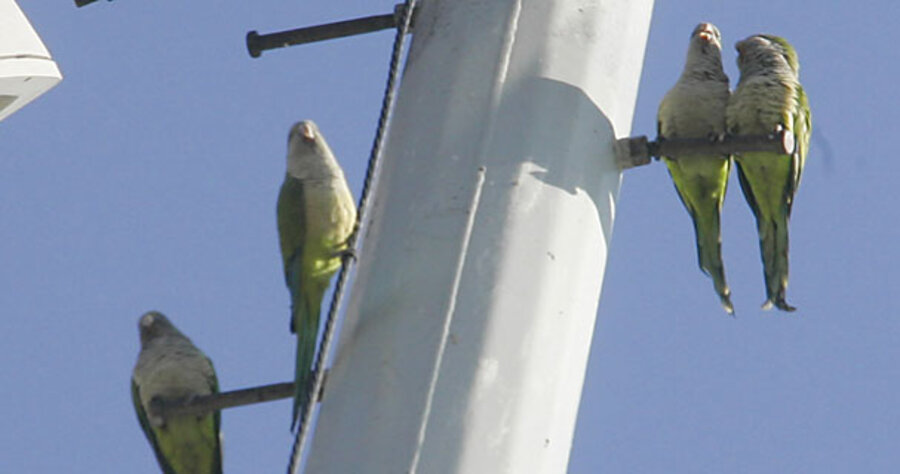Unlikely residents: Tropical parrots thrive in US cities
Loading...
Q: What are the conservation implications of all the wild colonies of escaped pet parrots that have turned up in and around some major US cities?
– Mike Gifford, Kirkland, Wash.
A: At least three dozen parrot species are now considered threatened or endangered in their quickly shrinking native tropical and subtropical habitats (mostly in South America). As such, the health of wild flocks in the United States and other developed countries around the world may be key to preserving these birds.
Today, wild parrot flocks thrive in urban and suburban areas of New York, New Jersey, Connecticut, Florida, Texas, Washington State, California, and elsewhere. San Francisco and Brooklyn host particularly large flocks, especially considering their relative lack of green space. Wild parrot flocks reportedly thrive in cities across Europe. Most of these parrots are not former pets, but descendents of birds that escaped during transport from their jungle homes to pet stores long ago.
Parrots are among the most intelligent and adaptable birds, so it is no surprise that they’ve done so well in North America and other regions, despite colder temperatures. Indeed, it is not uncommon in the Northeast to see large groups of parrots perched in winter on deck railings piled with snow. The regions they inhabit, despite the cold weather, provide enough food and shelter to meet their relatively modest needs. And once the parrots established themselves in their new habitats, they got on with the business of breeding. Their offspring, though born in the city, are wild birds, living lifestyles not unlike those of their ancestors back in the jungles of South America.
Conservationists are optimistic that the parrots’ adaptation to more northerly urban environments bodes well for their future, despite the loss of much of their ancestral habitat.
According to Roelant Jonker of nonprofit City Parrots, encouraging the formation of wild flocks of urban parrots promises to be a much more effective conservation tactic than raising more birds in captivity, where they would not so readily learn the survival, adaptation, and social skills needed to survive. Mr. Jonker points to the 2,500 wild red-crowned Amazon parrots (one-quarter of the world’s total) thriving in and around California’s biggest urban areas as their numbers plummet in their native habitat.
Q: How much of an effect, if any, does the carbon dioxide in carbonated beverages have on global warming?
– Michael Holmes, Shenandoah, Va.
A: Cans and bottles of sodas emit very little CO2 directly when opened, but the production and distribution of single-serving beverages of all kinds generate millions of tons of greenhouse gases and other pollutants, while using billions of gallons of fresh water. And once the drinks have been consumed, all those cans and plastic bottles have to go somewhere.
Recycling helps, but more than 40 million cans end up in landfills each year.
A typical 12-ounce can of soda contains up to six grams (0.21 ounces) of carbon dioxide gas, which either escapes into the atmosphere from the liquid upon opening, or from your body after you consume the contents. So yes, drinking carbonated beverages does contribute to your “carbon footprint,” but only ever so slightly.
To provide some context, every time you burn a gallon of gas driving from point A to B in your car, about 20 pounds of carbon dioxide wafts skyward (visit the US Department of Energy’s fuel economy website at: www.fueleconomy.gov/feg/co2.shtml). So a typical car commute to work produces upwards of 700 times the greenhouse gas as drinking that can of cola.
If you can’t get by without soft drinks, the best way to lower your carbon footprint is to buy them in large containers. A two-liter plastic soda bottle holds 5-1/2 times that of a 12-ounce can, so it’s easy to imagine the resource savings over time.
Got an environmental question? Write: EarthTalk, c/o E – The Environmental Magazine, Box 5098, Westport, CT 06881. Or e-mail: earthtalk@emagazine.com





